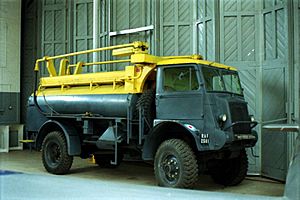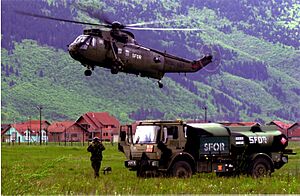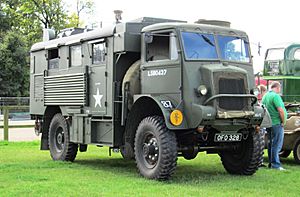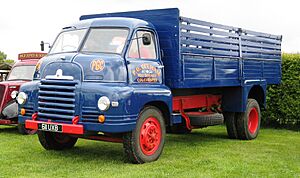Bedford Dunstable plant facts for kids
| Built | 1942 |
|---|---|
| Location | Dunstable, Bedfordshire, England |
| Industry | Motor vehicle assembly |
| Products | Bedford Vehicles |
| Employees | 5,500 |
| Area | 98 acres (40 ha) |
| Defunct | 1992 |


The Bedford Dunstable plant was a large factory in Dunstable, Bedfordshire, England. It was famous for building trucks and buses. Vauxhall Motors first opened this factory in 1942. It was built to help with production during World War II. Later, in the 1950s, it became part of the Bedford Vehicles company. The factory closed its doors in 1992. After that, it was taken down and the land was used to build a shopping area and other businesses.
Contents
Building the Bedford Dunstable Plant
In 1931, Vauxhall Motors, which was owned by General Motors, started a new part of their company. This new part was called Bedford Vehicles. It focused on making buses and trucks. At first, the Bedford vehicles were based on Chevrolet designs. But soon, Bedford started making its own unique designs. One of their first original designs was the Q series of trucks and buses. This helped Bedford become a well-known brand.
Why the Factory Was Needed
When World War II began, Bedford became a very important supplier for the British Army. Their Q series trucks were used for many different jobs. Some trucks even had to be tested in a lake to make sure they were waterproof for D-Day. To help with the war effort, the government asked Vauxhall to build Churchill Tanks. This meant Vauxhall needed more space to build things. So, with money from the government, Vauxhall agreed to open a brand new factory in Dunstable.
History of the Dunstable Factory
The factory opened in 1942 on a large piece of land, about 98 acres (40 ha) big. It was located on Boscombe Road in Dunstable. Since many of the vehicles were for the war, the factory had its own railway lines. These lines brought in materials and took out the finished trucks and buses.
Moving Production to Dunstable
In the 1950s, a big decision was made. All truck and bus production was moved from Vauxhall's original factory in Luton to the new Dunstable plant. The Luton factory continued to make vans until the Bedford brand stopped making them in the late 1980s. General Motors invested a lot of money in Dunstable. They built two huge new factories between 1955 and 1957. These new buildings covered an area of 46 acres (19 ha). The production line inside was very long, about 1 mile (1.6 km)! At its busiest, the factory employed 5,500 people.
Changes in the 1980s
By the 1980s, Bedford mainly focused on making military vehicles. They also built bus chassis for cheaper coaches. However, the factory started to get smaller, and jobs were lost.
A big problem happened when Bedford did not win a contract from the UK Ministry of Defence. This contract was to build a standard 4-ton truck for the British forces. Even though Bedford's truck performed just as well as the Leyland truck in tests, Leyland won the contract. Many people thought this decision was political. The government wanted to help Leyland survive and form Leyland-DAF. This decision also affected General Motors in Detroit. They had already been told they couldn't buy the Land Rover company. General Motors had hoped to combine Land Rover with Bedford to become a major force in military and civilian 4x4 vehicles.
With cheaper and more advanced vehicles coming from other countries, General Motors decided to change the Bedford brand. They would now focus on light vans, which would be re-badged Isuzu models assembled in Luton. So, the decision was made to sell the Bedford brand and the Dunstable factory.
New Owners: AWD
In 1987, the Dunstable factory and its business were sold to a company called AWD Ltd. This company was owned by David John Bowes Brown. The name AWD was used because General Motors only allowed the Bedford name to be used for military trucks. David John Bowes Brown was known for designing large dump trucks.
AWD continued to make the TL and TM truck ranges. They also produced the AWD Bedford TK, which was an updated version of an older Bedford truck. This truck was supplied to the British military. However, due to cheaper competition and a tough market, AWD went out of business in 1992. The AWD brand was bought by another company, but the Dunstable factory was set to be redeveloped.
What Happened Next: Redevelopment
In 1987, a team started planning what to do with the factory site. They successfully got permission to build shops on part of the land. The oldest buildings at the factory were taken down starting in 1993.
The first area to be redeveloped was near Dunstable Road. A Sainsbury's supermarket was built there first. Then, other shops like McDonald's and Kwik-Fit opened. In 1997, more old buildings were demolished. A new shopping area was built north of Sainsbury's. Today, this area includes stores like Staples, Kentucky Fried Chicken, Currys, and DFS furniture.
The two large factories built in the 1950s were rented out as storage and distribution centers. Companies like IKEA used them. These buildings were eventually taken down in 2005, along with the factory's tall water tower. New, modern distribution buildings were built in their place. These are now used by companies such as Cinram UK Ltd, Superdrug Ltd, and Christian Salvesen. Christian Salvesen handles parts distribution for IBC Vehicles, which is one of the companies that came after Bedford and Commer, and also for Renault Trucks.



